US Industrial Sensors Market Size
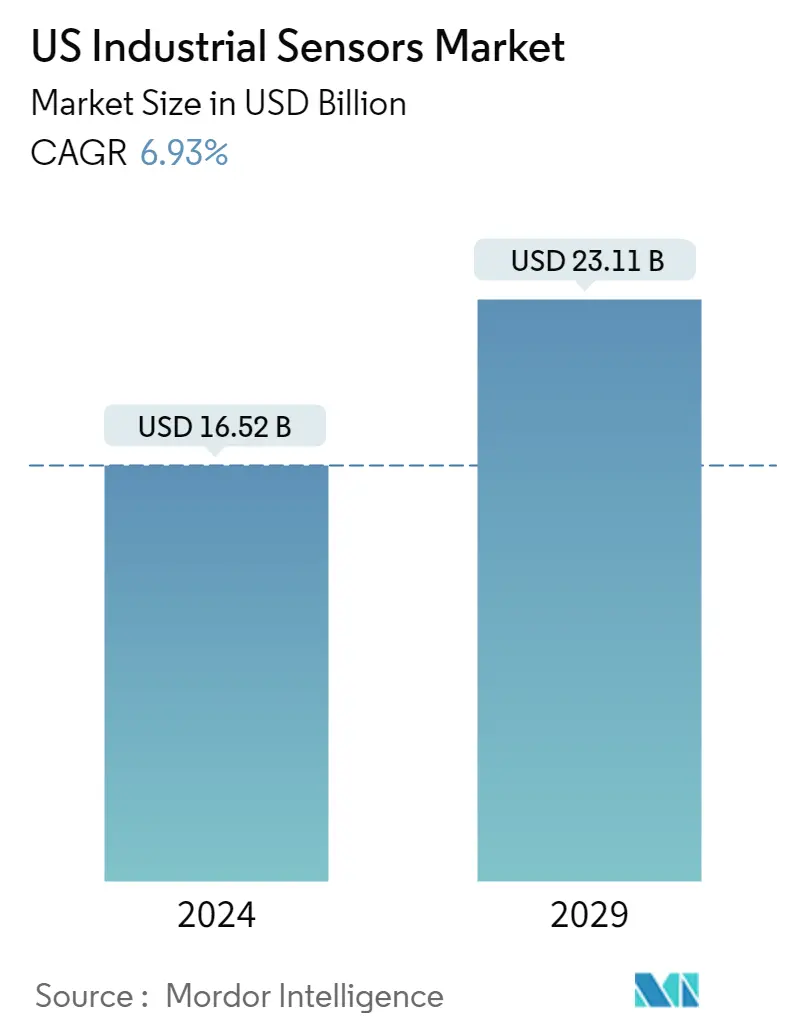
| Study Period | 2019 - 2029 |
| Base Year For Estimation | 2023 |
| Market Size (2024) | USD 16.52 Billion |
| Market Size (2029) | USD 23.11 Billion |
| CAGR (2024 - 2029) | 6.93 % |
| Market Concentration | Low |
Major Players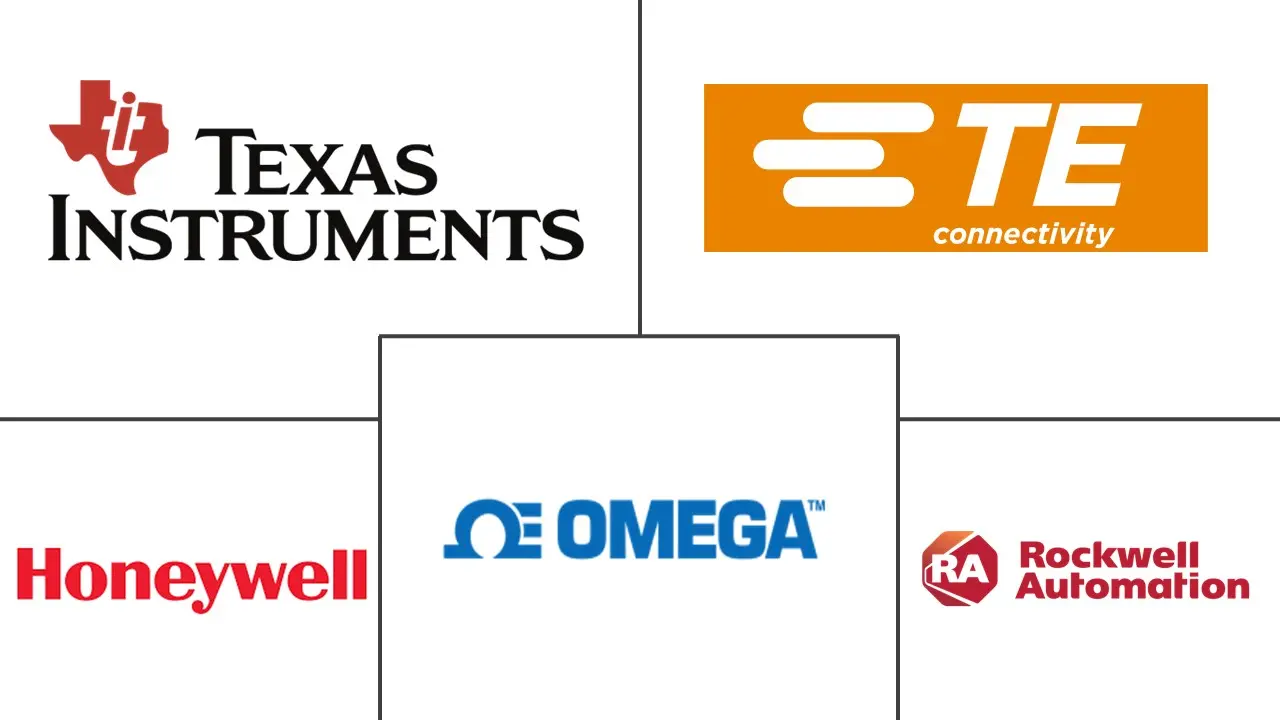
*Disclaimer: Major Players sorted in no particular order |
US Industrial Sensors Market Analysis
The US Industrial Sensors Market size is estimated at USD 16.52 billion in 2024, and is expected to reach USD 23.11 billion by 2029, growing at a CAGR of 6.93% during the forecast period (2024-2029).
Industrial sensors are a crucial part of factory automation and Industry 4.0. Sensors such as motion, environmental, and vibration sensors are used to monitor equipment health, from linear or angular positioning, tilt sensing, leveling, shock, or fall detection. United States industries are positioned to augment their operations economically and demographically, serving both domestic interests and export possibilities, which will rise soon.
- An industrial sensor system is often powered by a 24V DC source, which is very different from a sensor in a consumer system that is powered by a 3V or 5V source. As a result, industrial sensor systems require additional power management to drive the sensors effectively. These use digital outputs such as IO-Link directly to a microcontroller or the wireless transceiver.
- The increasing adoption of IoT in the United States can be attributed to factors like rapid digitalization, technological advancements, government initiatives, policies, and investments aimed at promoting digital transformation and Industry 4.0. Due to Industry 4.0 and the acceptance of IoT, massive shifts in manufacturing require enterprises to adopt agile, smarter, and innovative ways to advance production with technologies that complement and augment human labor with automation and reduce industrial accidents caused by process failure. With the high adoption rate of connected devices and sensors and the enabling of M2M communication, there has been an increase in the data points generated in the manufacturing industry.
- Although the global automotive sector witnessed a recession in the past two years, the trend was also reflected in the United States. The number of sensors and sensor components increased in the sector. MEMS pressure sensors have witnessed significant adoption in the smart automotive sector in the last few years. For the same, Asystom launched a range of multi-sensor IIoT devices featuring increased autonomy.
- The multi-sensor capability has addressed the predictive maintenance needs of a wide array of industrial equipment, integrating new on-board, connected, energy-saving electronics performing in situ analysis. Apart from increased performance, these innovative products are eco-responsible and 100% upgradeable.
- Although the integration of sensors increases the industrial automation level, it incurs an additional cost, which limits the use in cost-sensitive applications. Additionally, high development costs involved in the research and development activities to manufacture new products act as a critical challenge, mainly for the cash-deficient small and medium-sized sensor manufacturers. While the cost disparity has been declining in the past few years, they still cost more. However, as productivity is crucial in several industrial settings, these sensors have been widely adopted by multiple organizations across the region. However, higher initial investment still poses a significant challenge to the market's growth.
US Industrial Sensors Market Trends
Growing Adoption of IoT Leading to Demand for Sensing Components Drives the Market
- The Internet of Things (IoT) is a critical component of Industry 4.0. It has extensive applications in the monitoring of production systems in manufacturing and services. This technology opens up new and innovative possibilities in manufacturing by facilitating higher performance. The implementation and use of the Internet of Things transformed how industries operate, communicate, and utilize data, and it is only continuing to grow.
- The Industrial Internet of Things enabled industries to rethink business models, generating actionable information and knowledge from IIoT devices. A data-sharing ecosystem started to build new revenue streams and partnerships.
- On the other hand, aggregated and real-time data from sensors led to the development of robots that can take specific actions because of these built-in capabilities, whereby IIoT becomes a driver of 'decision-making' devices. This happened in warehouses as the Internet of Robotic Things (IoRT). As an essential aspect of digital transformation, IoT technology is becoming increasingly important in the manufacturing industry.
- The consistent and reliable performance of sensors has led the assets in heavy industrial operations to drive critical daily metrics. Manufacturers are constantly monitoring the uptime of assets along their production lines. IIoT integrates legacy machinery commonplace within these complex industries via industrial connectivity with IIoT platforms for different use cases, roles, and applications.
- IIoT uses smart sensors to monitor and improve industrial processes and equipment. These sensors capture and analyze data about machines, components, and techniques in real time and then transmit that data for storage, further analysis, or to notify a technician or operator that something is going wrong. According to the Global System for Mobile Communications Association, by 2025, North America's total number of consumer and industrial Internet of Things (IoT) connections is forecast to grow to 5.4 billion.
- Moreover, various manufacturers are deploying sensors in IoT devices to boost their performance. For instance, in May 2023, iMatrix Systems, a US-based provider of Internet of Things (IoT) solutions, launched a range of temperature and humidity sensors designed for use in food and produce storage, transport monitoring, pharmaceutical, and agriculture applications. The NEO series sensors can quickly and accurately measure changes in temperature and humidity, making them ideal for use in dynamic refrigeration environments like cold storage and refrigerated transportation.
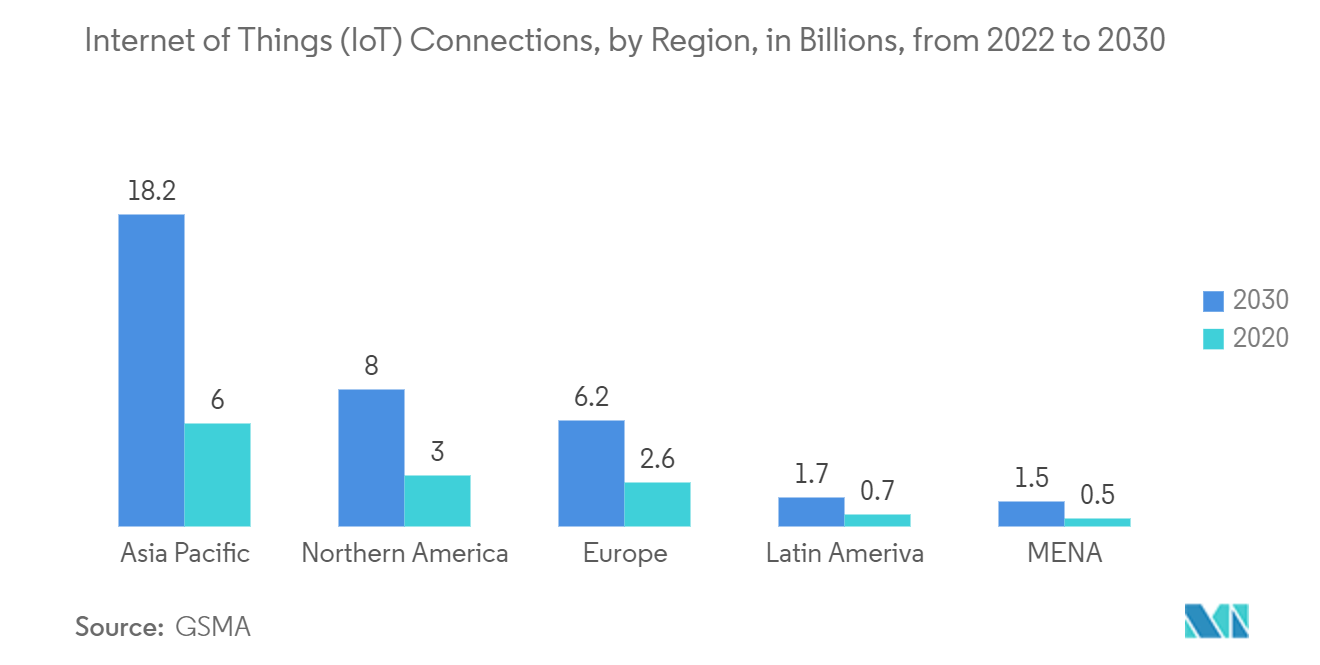
Pressure Sensors to Hold Significant Market Share
- Pressure sensors are utilized to monitor relative system pressure in many process applications, as well as hydraulics and pneumatics. These sensors have witnessed significant growth over the years owing to the increasing applications across various industries, such as aerospace, automotive, healthcare, consumer goods, etc. Ranging from laboratory applications to plant and mechanical engineering, pressure and level measuring devices have become as diverse as their areas of application, thanks to the evolution of measurement technologies.
- In the past few years, exclusive cross-country and off-road cars have been installed with an innovative tire pressure control system. For instance, the G63 AMG 6X6 from the Mercedes enables the driver to check and vary the tire pressure of both the front and rear axles separately. Reportedly, the system takes less than 20 seconds to raise the tire pressure from 0.5 bar to 1.8 bar. Such applications, coupled with increasing demand for Tire Pressure Monitoring Systems (TMPS), are expected to govern the need for pressure sensors in tire pressure applications over the forecast period.
- Piezoresistive and capacitive sensors dominate the pressure sensors market as they are increasingly used in the automotive, medical, petrochemical, oil, and gas industries. Optical and resonant solid-state sensors are anticipated to exhibit increased growth over the forecast period due to their applications in hazardous environments.
- For instance, in September 2023, Baker Hughes, an energy technology company, announced the launch of its latest product for hydrogen-druck hydrogen-rated pressure sensors. Designed to offer longer-term stability and withstand harsh environments, the hydrogen pressure sensors can be used in various applications, including gas turbines, hydrogen production electrolysis, and hydrogen filling stations.
- The medical industry is also observing significant growth opportunities owing to rising geriatric populations, increasing healthcare expenditures, and growing chronic diseases among the considerable population. The USA spends more money on healthcare per person than any other country in the world. Nevertheless, the United States has a distinct method of funding their healthcare system, with most of the costs being covered by private insurance. In the fiscal year 2023, private insurance covers approximately one third of total health spending.
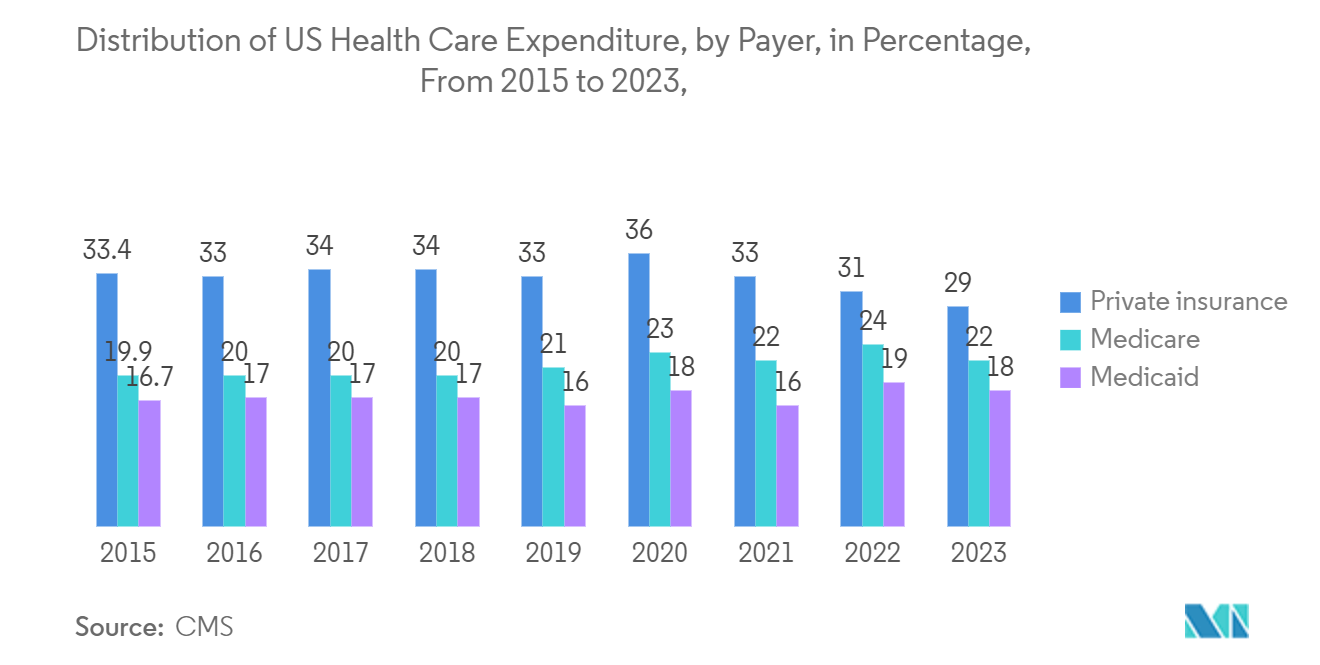
US Industrial Sensors Industry Overview
The United States Industrial Sensors Market is highly fragmented, with the presence of major players like TE Connectivity Ltd, Omega Engineering Inc., Honeywell International Inc., Rockwell Automation Inc., and Siemens AG. Players in the market are adopting strategies such as partnerships and acquisitions to enhance their product offerings and gain sustainable competitive advantage.
- June 2023 - STMicroelectronics introduced the first MEMS water/liquid-proof absolute pressure sensor with a declared 10-year longevity program for the industrial market. The latest waterproof pressure sensors provide the environmental robustness needed to power digital transformation with the long-term availability necessary to protect customers' MEMS designs.
- January 2023 - Quadric and ams OSRAM established a collaborative partnership to create integrated sensing modules that combine the cutting-edge Mira Family of CMOS sensors for visible and infrared light with Quadric's advanced Chimera GPNPU processors. The integrated ultra-low power modules will allow wearable technology to use new types of smart sensing.
US Industrial Sensors Market Leaders
-
TE Connectivity Ltd
-
Omega Engineering Inc.
-
Honeywell International Inc.
-
Rockwell Automation Inc.
-
Siemens AG
*Disclaimer: Major Players sorted in no particular order
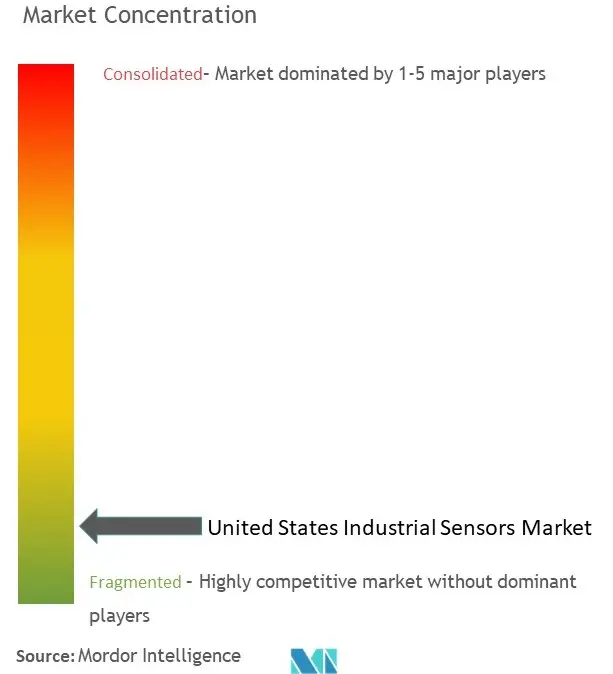
US Industrial Sensors Market News
- September 2023 - KROHNE, Inc. announced to showcase a wide range of its industry-leading water and wastewater products, including the latest version of the OPTISONIC 6300 clamp-on ultrasonic flowmeter at WEFTEC 2023. Likewise, in January 2023, the company announced to exhibit products for food and beverage production at the Food Processing Expo 2023, which includes the OPTISONIC 6300P ultrasonic clamp-on flowmeter, the WATERFLUX 3070 electromagnetic water meter, and the OPTIFLUX 2000 electromagnetic flow sensor.
- January 2023 - Bosch Sensortec has introduced a range of new sensors at CES 2023, including an AI-enabled sensor and a next-generation magnetometer. The new BMP585 barometric pressure sensors enable a range of altitude tracking in harsh conditions, such as for wearables for swimming. The new sensor claims ultra-low power consumption for extended battery life, high accuracy, and low noise.
US Industrial Sensors Market Report - Table of Contents
1. INTRODUCTION
1.1 Study Assumptions and Market Definition
1.2 Scope of the Study
2. RESEARCH METHODOLOGY
3. EXECUTIVE SUMMARY
4. MARKET INSIGHTS
4.1 Market Overview
4.2 Industry Attractiveness - Porter's Five Forces Analysis
4.2.1 Bargaining Power of Suppliers
4.2.2 Bargaining Power of Buyers
4.2.3 Threat of New Entrants
4.2.4 Threat of Substitutes
4.2.5 Degree of Competition
4.3 Industry Value Chain Analysis
5. MARKET DYNAMICS
5.1 Market Drivers
5.1.1 Growing Adoption of IoT Leading to Demand for Sensing Components
5.1.2 Growing Emphasis on the Use of Predictive Maintenance and Remote Monitoring
5.2 Market Challenges/Restraints
5.2.1 High Cost and Operational Concern
6. MARKET SEGMENTATION
6.1 By Connectivity
6.1.1 Wired Solutions
6.1.2 Wireless Solutions
6.2 By Type
6.2.1 Flow Sensors
6.2.1.1 Market Overview
6.2.1.2 End-user Industry
6.2.2 Temperature Sensors
6.2.2.1 Market Overview
6.2.2.2 End-user Industry
6.2.3 Level Sensors
6.2.3.1 Market Overview
6.2.3.2 End-user Industry
6.2.4 Pressure Sensors
6.2.4.1 Market Overview
6.2.4.2 End-user Industry
6.2.5 Gas Sensors
6.2.5.1 Market Overview
6.2.5.2 End-user Industry
6.2.6 Other Sensors
7. COMPETITIVE LANDSCAPE
7.1 Company Profiles*
7.1.1 Texas Instruments Incorporated
7.1.2 TE Connectivity Ltd
7.1.3 Omega Engineering Inc.
7.1.4 Honeywell International Inc.
7.1.5 Rockwell Automation Inc.
7.1.6 Siemens AG
7.1.7 Stmicroelectronics Inc.
7.1.8 Ams-osram AG
7.1.9 NXP Semiconductors N.V.
7.1.10 Bosch Sensortec GMBH (Bosch Internationals)
7.1.11 Sick AG
7.1.12 ABB Ltd
7.1.13 Omron Corporation
7.1.14 Emerson Electric Co.
7.1.15 Endress + Hauser AG
7.1.16 The Krohne Group
7.1.17 Yokogawa Electric Corporation
7.1.18 Meggitt Sensing Systems
7.1.19 Vega Grieshaber KG
7.1.20 Analog Devices, Inc.
7.1.21 Sensata Technologies Inc.
7.1.22 Infineon Technologies AG
8. MARKET OUTLOOK
8.1 Impact of Current Geopolitical Scenarios on the Market
8.2 Impact of Anticipated Economic Slowdown/Recession
US Industrial Sensors Industry Segmentation
Industrial sensors are devices that may sense changes in the environment and provide an output signal with respect to input or change in the environment. These sensors can sense physical input, such as light, heat, motion, moisture, pressure, or any other entity, and respond by producing an output on display or transmitting the information in electronic form for further processing.
The scope of the study includes the different types of sensors used in Industrial applications, with the prominent industries in the scope being chemicals and petrochemicals, oil and gas, water and wastewater, food and beverage, power, aerospace and military, life sciences, and other end-user industries in the United States. The study also tracks the key market parameters, underlying growth influencers, and major vendors operating in the industry, which supports the market estimations and growth rates during the forecast period. The study further analyzes the overall impact of macroeconomic trends on the ecosystem.
The United States Industrial Sensors Market is Segmented by connectivity (wired solutions, wireless solutions), by type (flow sensors, temperature sensors, level sensors, pressure sensors, gas sensors). The report offers market forecasts and size in value (USD) for all the above segments.
| By Connectivity | |
| Wired Solutions | |
| Wireless Solutions |
| By Type | ||||
| ||||
| ||||
| ||||
| ||||
| ||||
| Other Sensors |
US Industrial Sensors Market Research Faqs
How big is the US Industrial Sensors Market?
The US Industrial Sensors Market size is expected to reach USD 16.52 billion in 2024 and grow at a CAGR of 6.93% to reach USD 23.11 billion by 2029.
What is the current US Industrial Sensors Market size?
In 2024, the US Industrial Sensors Market size is expected to reach USD 16.52 billion.
Who are the key players in US Industrial Sensors Market?
TE Connectivity Ltd, Omega Engineering Inc., Honeywell International Inc., Rockwell Automation Inc. and Siemens AG are the major companies operating in the US Industrial Sensors Market.
What years does this US Industrial Sensors Market cover, and what was the market size in 2023?
In 2023, the US Industrial Sensors Market size was estimated at USD 15.38 billion. The report covers the US Industrial Sensors Market historical market size for years: 2019, 2020, 2021, 2022 and 2023. The report also forecasts the US Industrial Sensors Market size for years: 2024, 2025, 2026, 2027, 2028 and 2029.
US Industrial Sensors Industry Report
Statistics for the 2024 US Industrial Sensors market share, size and revenue growth rate, created by Mordor Intelligence™ Industry Reports. US Industrial Sensors analysis includes a market forecast outlook to for 2024 to 2029 and historical overview. Get a sample of this industry analysis as a free report PDF download.



